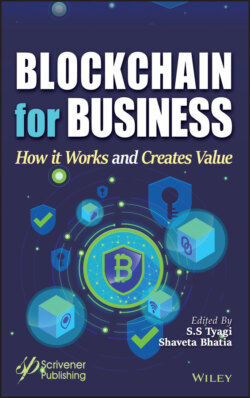Читать книгу Blockchain for Business - Группа авторов - Страница 29
1.6 Decentralization Challenges Exist in Blockchain
ОглавлениеThe very basic definition of Blockchain states and implies that, in relation to Figure 1.6, it is a decentralized ledger that can store information quite securely and immutably, utilizing cryptographic encryption and hashing techniques. But it seems in reality, that the word ‘decentralized’ is somehow stuck only to the definition [5]. A number of Blockchains out there in the market make use of centralized mechanisms.
But what exactly does this word “decentralization” means? Does it only refer to data being processed “not at the same place (distributed)?”
As explained by Vitalik Buterin in his blog, the decentralization can be categorized or viewed into three perspectives—first is “Architectural”. This states the number of physical computers attached or is in the network? Second comes “Political”—How many entities control these computers? And the last “Logical”—that derives that does the data structure and interfaces of the computers or systems act like a single structure or a swarm [5]?
No one controls Blockchains and they don’t have the infrastructural central or head point of failure. Hence, they are politically and architecturally decentralized. However, they are or can be said logically centralized since they act and behave like a single entity/computer.
But even if the above definition is correct and acceptable, then are blockchains as they are today decentralized?
Figure 1.6 Different types of Networks in blockchain [5]. (a) Centralized. (b) Decentralized. (c) Distributed networks.
The answer majorly comes is NO, because of these possible reasons:
Having four computers instead of having one is always better. But what if all the computers get infected with same issue or defect?
All the nodes in a Blockchain run the same client software, and if they get some issues or turns out to be buggy, reason may be any or then the whole system can come to a pause/standstill. This can put a question mark on the architectural decentralization of the Blockchains [5, 6].
In a Blockchain which uses the proof-of-work consensus mechanism and majority of the miners are from the same country, the government of that country can choose or decide to seize and control or stop all the mining farms on the account of national security [7]. This scenario or case is a major threat to the political decentralization of Blockchain.
Similarly, in a proof of stake Blockchain, if more than 70% of the coins at stake are held at one exchange, can put the political decentralization of the Blockchain at risk.
Moreover, if the majority of mining hardware (infrastructure) is built by the same company, it can also compromise the political decentralization of the Blockchain [8].
So, that means centralized Blockchains are not that good or of no use?
Not majorly, and this is because Blockchains serve various purposes, and these may require them to be centralized.
According to the report of Crytpo asset Taxonomy, about 16% of crypto currencies are said to be fully decentralized. The other crypto currencies reviewed are either centralized, or only semi-decentralized. Only 9% of all utility tokens were found to be sufficiently decentralized and only 7% of financial assets such as those born from initial coin offerings are decentralized [9, 10]. Crypto currencies such as Bitcoin, Stellar, Litecoin that work primarily as a payment method are among the most decentralized types of crypto assets, as per the report.
While the original crypto currency—Bitcoin, was designed and developed to be decentralized and removing the control of governments or any central organization, some experts claim and suggest that even Bitcoin can’t be termed as fully decentralized since a majority of the Bitcoin miners are from China.
